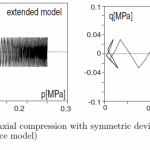Dear all,
After carefully reading the matlab drivers of hypoplastic models, I was wondering why there is not mix control undrained TX compression. I want to achieve the same result as Niemunis and Herle(1997) did. How can I make the value of q fluctuates within a certain range .When I make dsigma11-dsigma33=DX , and DX=[30,-60,60,-60,60,-60,60,-60,60,-60,60,-60] , the result is clearly not right. Any suggestions or comments will be appreciated. Thank you!
Question on the Matlab driver-hypoplastic models
Related Articles
-
Velacs Project Data
 WaiChing Sun||Constitutive Modelling|1 |Views 4,063
WaiChing Sun||Constitutive Modelling|1 |Views 4,063
Dear colleagues, I want to ask your help — does anyone know where we can find all the test data from the old Velacs Project? If so, that would be […] -
SSE and SPD Mohr Coulomb Crieria
 Matías Sáez de Tejada||Constitutive Modelling|1 |Views 4,573
Matías Sáez de Tejada||Constitutive Modelling|1 |Views 4,573
I have a UMAT of Mohr Coulomb with no hardening, where i have to define SSE (specific strain energy) and SPD (specific plastic dissipation). Any idea? -
Triaxial Callibration test with Hypoplasticity
 pooyan ghasemi||Constitutive Modelling|3 |Views 3,997
pooyan ghasemi||Constitutive Modelling|3 |Views 3,997
Dear all I am trying to calibrate the HP for sand, and I have quite comprehensive data. but they are not totally consistent with each other . we have the […] -
Hypoplastcity sand model
 Pooja Patil||Constitutive Modelling|11 |Views 4,424
Pooja Patil||Constitutive Modelling|11 |Views 4,424
Not able to run the subroutine ……..error is coming ……UMAT: illegal (negative) actual void ratio detected Can anybody help -
Cyclic Triaxial Test
 Mehdi Joneidi||Constitutive Modelling|2 |Views 4,494
Mehdi Joneidi||Constitutive Modelling|2 |Views 4,494
Dear All, I am using ISA+HP model in my research and I have encountered some problem when looking into cyclic triaxial test for single element. The target model was selected […] -
Modelling Rate-dependent behaviour of clay [Urgent]
 Balaji Bandaru||Constitutive Modelling|0 |Views 3,872
Balaji Bandaru||Constitutive Modelling|0 |Views 3,872
Using PLAXIS, how to model rate dependent behavior of clay. This is to show the viscous behavior of the soil. Thank you in advance -
ALERT Geomaterials – SoilModels support declaration
 David Mašín||Constitutive Modelling|0 |Views 4,189
David Mašín||Constitutive Modelling|0 |Views 4,189
ALERT Geomaterials (The Alliance of Laboratories in Europe for Education, Research and Technology) is a European organisation including 33 Universities or Organisations, which are most active in the field of numerical […] -
Hardening Soil Model in Abaqus
 Abulimiti Ayizula||Constitutive Modelling|5 |Views 5,307
Abulimiti Ayizula||Constitutive Modelling|5 |Views 5,307
Is there Hardening Soil Model in Abaqus?
Search SoilModels Website
Recent posts
-
 Degradation ( disturbance ) of hypoplastic clay 23.4.2024
Degradation ( disturbance ) of hypoplastic clay 23.4.2024
-
 Degradation ( disturbance ) of hypoplastic clay 23.4.2024
Degradation ( disturbance ) of hypoplastic clay 23.4.2024
-
 Paper of Coulomb, C. A. (1773) 15.4.2024
Paper of Coulomb, C. A. (1773) 15.4.2024
-
 ABAQUS UMAT of hypoplastic clay model 6.4.2024
ABAQUS UMAT of hypoplastic clay model 6.4.2024
-
 Prague Geotechnical Days 2024 “Geotechnical monitoring” and 30th jubilee Prague Geotechnical Lecture by prof. Eduardo Alonso 5.4.2024
Prague Geotechnical Days 2024 “Geotechnical monitoring” and 30th jubilee Prague Geotechnical Lecture by prof. Eduardo Alonso 5.4.2024
-
 UMAT for Creep-SCLAY model. 1.3.2024
UMAT for Creep-SCLAY model. 1.3.2024
-
 Cyclic tests with Triax element test driver 14.2.2024
Cyclic tests with Triax element test driver 14.2.2024
-
 SUMMER SCHOOL ‘Numerical Modelling in Geotechnical Engineering’, Innsbruck – July 22nd-26th, 2024 1.2.2024
SUMMER SCHOOL ‘Numerical Modelling in Geotechnical Engineering’, Innsbruck – July 22nd-26th, 2024 1.2.2024
-
 COURSE IN SOIL MODELING – NTNU, Trondheim – October 14th to 18th, 2024 21.12.2023
COURSE IN SOIL MODELING – NTNU, Trondheim – October 14th to 18th, 2024 21.12.2023
-
 MSE walls design in Plaxis 11.12.2023
MSE walls design in Plaxis 11.12.2023
-
 sand liquefaction modelling in Anura3D 8.12.2023
sand liquefaction modelling in Anura3D 8.12.2023
-
 BCV bentonite experimental and modelling datasets 14.11.2023
BCV bentonite experimental and modelling datasets 14.11.2023
Recent Comments
- Jh Xue on Undrained Tests with Clay Hypoplasticity Intergranular
- Zhentao Liu on Problem in simulating CPT using SANISAND04
- Gertraud Medicus on ABAQUS UMAT of hypoplastic clay model
- Chen Zhiming on Download Package of Charles University Implementation of High Cycle Accumulation Model
- Konstantinos Chatzis on Cyclic tests with Triax element test driver
- Abhay Pratap Singh on Cyclic tests with Triax element test driver
- Giovanni Ciardi on Cyclic tests with Triax element test driver
- Konstantinos Chatzis on Cyclic tests with Triax element test driver
- Ismail Khan on Cyclic tests with Triax element test driver
- Kanika Lamba on Cyclic tests with Triax element test driver
- Arie Koot on How to model the settlement in soil due to water drawdown.
- Konstantinos Chatzis on Cyclic tests with Triax element test driver
- Jose Duque on Cyclic tests with Triax element test driver
- MohamadReza Kamali on How to model the settlement in soil due to water drawdown.
- Leo Alibert on MSE walls design in Plaxis
- Ignacio Zuloaga on MSE walls design in Plaxis
- Giada Orlando on Problem with VUMAT interface
- Michael Spyridis on Problem with VUMAT interface





Hi C, the mixed control is not there predefined, but you can still add it easily into constraints.m file. Please study Janda, T. and Mašín, D. (2017). General method for simulating laboratory tests with constitutive models for geomechanics. International Journal for Numerical and Analytical Methods in Geomechanics 41, No. 2, 304-312 which is available in SoilModels publication database. You need to control axial stress
S(6,3)=1;
and radial strains so that zero volume strain is achieved
E(1,1)=1;
E(1,3)=0.5;
E(2,2)=1;
E(2,3)=0.5;
E(3,4)=1;
E(4,5)=1;
E(5,6)=1;
David
Hi, Prof.David. Thank you for your reply! As you mentioned, I change the constraint. However, there is still something wrong with it. I check the EE after I did what you mentioned, I found that the volume strain isn’t zero in the whole process. I was a little confused about these problems. I want to achieve the same result as Niemunis and Herle(1997) did. They controlled q fluctuates within a certain range. Is it possible for us achieve this through our matlab driver? Looking forward to your response!
Hmm, not sure why, this sets ep22=-ep33/2 and ep11=-ep33/2.
You may also try
E11=E12=E13=1, which sets ep11+ep22+ep33=0.
E21=1, E22=-1, which sets ep11=ep22
E34=E45=E56=1, which sets shear strain components to 0
S63=1, which sets axial (axis direction 3) stress control
This will, however, still not stop the test at predefined q, as radial stress will change during during loading through pore pressure generation. To achieve constant max and min q cyclic loading, you will have to manually set nstep for each load cycle, or add your own stop condition into the code, or better use some of more advanced element test software (such as triax or idriver).
Prof.David. in the f_hyp.m, after I make Laux = Lep and sigpresc = Laux*depsMNR-Nep*sqrt(depsMNR’*M2*depsMNR), the volume strain is zero, even though other results are not totally right in my views. While your file README.pdf clearly says that sigpresc = Laux*depsMNR rather than sigpresc = Laux*depsMNR-Nep*sqrt(depsMNR’*M2*depsMNR). I’d appreciate it if you could explain why sigpresc = Laux*depsMNR. Looking forward to your reply!
I see, I think the problem is how residual is calculated in Newton-Raphson iterations in Matlab driver. It is only calculated from residual stresses, which is insufficient for more complex mixed-controlled tests such as those we discuss here. Correct procedure is defined in Janda & Mašín (2017), where the residual is calculated from S*dsig+E*depsilon-dy, see Eq. (12).
For you, that would mean either updating Matlab driver formulation or using more advanced element test driver, such as triax